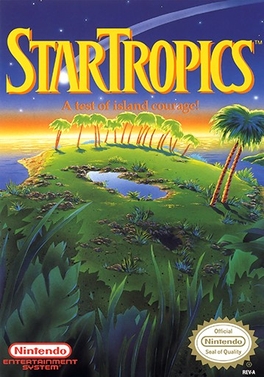

No time for love, you’ve got to save Dr. Jones!
StarTropics holds a wonderful space in my heart and memory. I’m not sure if we owned it, or just rented it frequentyl, but the early 90’s action platformer has always been one of my favorite video games.
I started re-playing this game with the Nintendo Online’s classic collections. I also tried to approach this game with the idea that I would only use the resources available at the time of release, and refrain from using save states. Then about 2 hours later I said “fuck that.”
This is a brutal, antagonizing, and frustrating adventure that would have been a quarter eater if it was an arcade classic (which I could totally see it as a stand up cabinet game). Without save states I would not have made it as far as I did, but that’s okay. If you think about when the game was released, it being a highly difficult game to tackle meant it got a lot of renting and replaying if you so desired.
I also want to preface this review with the fact that I did not finish the game, but sank a good 20 some hours into it. I forgot to check out the original manual to see what information I could ascertain before starting my play through. I died at the boss of Chapter 2 before finding an archived copy on the internet, and learned a little bit of information that would be good for a new player (or a player who ahsnt played since emulating in middle school reading class when your friend found out how to install files onto school servers. 1999 was a hell of a time to be a teenager.
Things I found out through the manual: it is both a travel guide to the island destination, main character’s diary, and evidence file of something nefarious(*gasp* foreshadowing!?), as well as holding the games instructions. Your main weapon is a yo-yo, which gets upgraded to a flail morningstar (Castlevania influence, check out the first Re-Rowe-View!) when our character has at least 6 hearts. It upgrades again at 11 hearts to shoot a projectile. The manual also gives us the names for other weapons and the magics you may encounter in the dungeon portions of the game. However, these descriptions do little to tell of the tactics required. We also learn the names of some enemies as well as some fun one liners regarding them.
Why I enjoyed this game originally: Having the completely common name of Mike, I was elated when characters shared my name. So I was hooked just through immersion from that. We also find out Mike is the star pitcher at his high school, and guess what? While not being a star pitcher in the community, I played little league for my uncle’s team and probably through a bit of nepotism, was one of the pitchers. I still enjoy a nice game of catch with the Conman.
The early 90s (when I originally played the game) was also a wonderful time for basketball, so a young me made a head canon that connected Dr. Jones and Mike Jones to Dr. J and Michael Jordan. I’m probably the only person to make this connection.
What I think now: I started my replay only with the thought, “This is a game I loved as a kid, and very few of my friends over the year would recall it as one they played.”
I got through Chapter 1 with no real issue. The game is pretty linear and can be tricky if you get greedy or careless (like most of the 8-bit/arcade generation). I found a “hidden” room that contained a health magic(potion) and then discovered a second room containing another. When I found another hidden door, I jumped right in and into a pit of water (death) as our protagonist cannot swim.
Why the hell would you visit an island if you can’t swim?
The further along you go the more unforgiving the game becomes. Some rooms all of a sudden turn dark and you better hope you know where to go. If this was an arcade, these rooms were designed to eat quarters. It’s almost impossible to get through some of them without trial and error over multiple continues. That’s where the miracle of save states came in handy.
I’m not above using the resources available to help me get by, but I like to try things on my own first. It’s the American way. So, where young gamers back in the day probably had to use graph paper and make their own maps, the internet is a beautiful and wonderful invention for us older gamers no longer have the time (or patience).
And I will try to keep myself honest and let you all know when I’ve resorted to such needs.
At Chapter 4(maybe?), and I only used save state twice and no guides. There is a review mode where you can replay levels so that might be something to check out. I don’t think I ever knew about it. I probably missed somethings in Chapter 3 as there was definitely a path I did not take right before the exit.
Also, me from a couple paragraphs ago was so naive about the difficulty. That damn dark room. I remember playing that damn room so many times. I finally decided I would look it up, but because this is re-reviews, I decided to look up Nintendo Power Volumes 21 and 22, which featured maps and tricks for the game. Volume 22 is where the 2nd half of the game starts and it was fun looking at the notes and hints that I had picked up naturally.
Now up to this point I was conservative in my use of the modern features given in the Nintendo Online collection, but then I hit the Ghost House. Invisble enemies, only to be seen by the magic rod of sight, and false paths that lead you back to the “travel world” make you lose your gained items, which aren’t much at this point, but annoying. The maps in Nintendo Power are quite useful, but the greatest power in your modern hands is the save state.
I really feel like half the games on the NES would have been programmed a lot different if you could magically save whenever you want. Ninja Gaiden would not have been nearly as bad to get through for a younger me. Contra probably wouldn’t have the Konami code left in for us plebians whop needed more than three lives. I’ve already discussed how it saved my ass in Castlevania.
I’m not trying to pretend I’m some gaming prodigy. Play how it makes you happy. I’m trying to replay some of the games I played and enjoyed as a kid and marvel at how we made it to the end without modern conveniences. I still try to challenge myself sometimes, but I need to stop pretending this was one of those times.
One thing I do not remember ever getting is the lantern. There is one section in the ghost house that you can find it with the help of Nintendo Power, the internet, or by jumping on every single tile (which this game rewards and encourages). But, damn that can sometimes feel like a really long time as the input timing is very 1990. That’s something that can make some of these old games feel their age to modern gamers. We are used to the instantaneous button presses and pushing the CPU to process everything we do faster and shinier. This was 1990 and we had 8bits. You learn how the game moves as opposed to catering the game to your specifications.
At this point I’ve given up any hope and save stated before every room I enter it seems like. Damn, fucking dark rooms and missteps. It relieves the anxiety from playing, but if you thrive on that, go for it old school. Again, play how you want.
One thing I noticed, enemy hitboxes will only scan one enemy, so if you have multiple in the same space you’ll only hit one. This will come in handy when you face rooms with mummies. If you catch multiple one the same square one will move forward unimpeded while the other gets hit. Keep moving and try to take them out one by one.
One other thing the game fails to mention is how the yo-yo upgrade system works. Once you receive the shooting star you have to have at least 6 hearts to use it properly…which means AT ALL. As soon as you go under 6 hearts it reverts back to the yo-yo. The shooting star upon first use shows you how much of an upgrade it really is. Same melee range as the yo-yo, but it grants an additional two blocks of ranged: hence the name shooting star. The damage is also twice that of the yo-yo, helping you take down pesky enemies that much faster.
Overall this replay was a spectacular ride through my own history. There are somethings that don’t hold up (frustrations in timing and items that aren’t 100% needed). The travel world seems way too large, and too linear. The villages you visit are way too large for what they needed to be. It’s as if these portions were tacked on to make the game larger and a little longer. We could have easily gotten something more akin to the map screen between levels like in Castlevania and Ghosts and Goblins, but we do learn more story through these travel portions.
Sound cues, map making, and thorough exploration bring to mind more of the connections to Metroid and Castlevania, where as the overland and dungeon system recalls the side scrolling Legend of Zelda 2: Adventure of Link, which I feel deserves more love and perhaps a 2DHD remake.
If you’ve never played StarTropics, it’s available on the Nintendo Switch Online’s Virtual NES, where I re-played.
Rating 3 out of 5: While I hold a special place in my heart for this game and the wild turns the story takes, it doesn’t hold up as much as I had expected. I was enthralled for a good two weeks before I got bored and DNF. Definitely give it a shot if you enjoy classic games and see how far you can get on a continue or two, but I don’t expect this to make a resurgence into the pop culture of modern gaming. Though, if someone with fond memories like me got a hold of the IP it might make for a fun indie platformer like Salt and Sanctuary.
